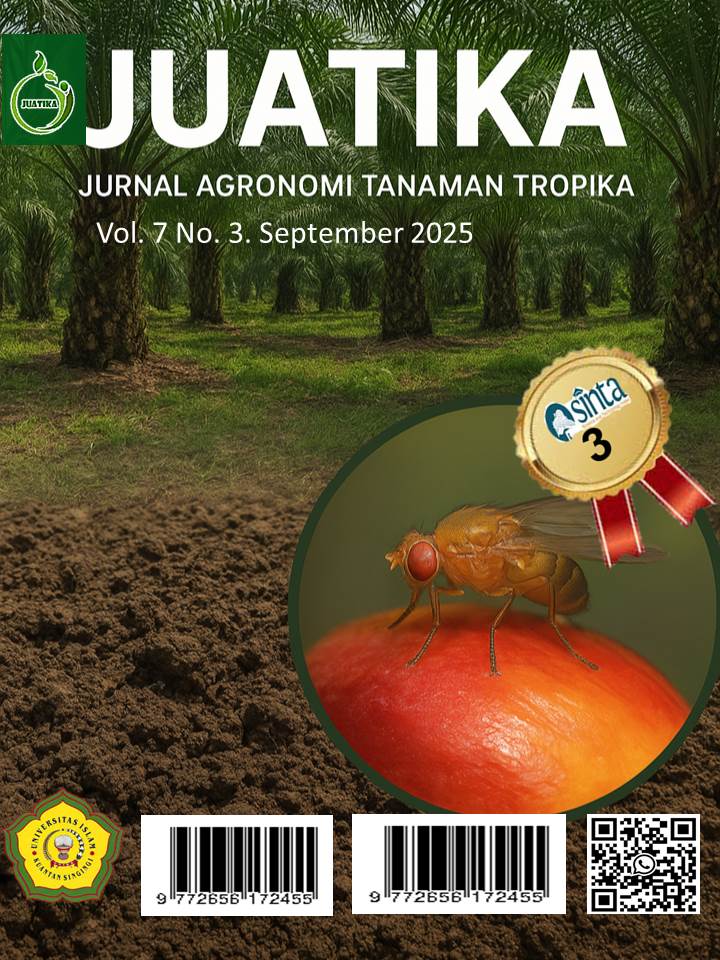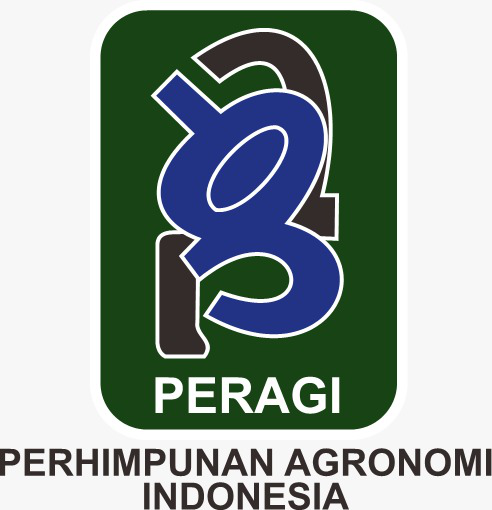Exploration of Phytochemical and Morphological Profile of Melastoma malabathricum from Central Kalimantan as a Tropical Plant with Therapeutic Value
Abstract
This study aimed to explore the morphological characteristics and phytochemical content of Melastoma malabathricum, a tropical plant native to Central Kalimantan, recognized for its therapeutic potential. Sampling was conducted purposively in its natural habitat, followed by morphological description and preliminary phytochemical tests to identify secondary metabolites using standard phytochemical screening methods (tube test). The results revealed that M. malabathricum exhibits distinctive morphological features in both vegetative and reproductive organs, including woody stems with prominent branches, single elliptical leaves with three pinnate veins and a hairy underside, bright purple flowers with prominent petals, small, round fruits that turn purple-black when ripe, and taproots with numerous branches. Phytochemical tests revealed the presence of flavonoids, tannins, saponins, and alkaloids, supporting the plant's pharmacological potential. Traditionally, this species has been used as a wound healer, anti-inflammatory agent, and antimicrobial remedy. M. malabathricum shows promise as a valuable source of natural bioactive compounds, facilitating research into the development of modern herbal medicines. These findings confirm that M. malabathricum not only exhibits unique morphological characteristics typical of tropical habitats but also holds significant potential for advancement in health and pharmacology. Due to its diverse secondary metabolite profile, this plant is an excellent candidate for phytopharmaceutical raw materials, warranting further research focused on isolating active compounds and evaluating their biological activities both in vitro and in vivo.
Downloads
References
Agustin, Y., Sapada, E., Wilsya, M., Studi, P., Farmasi, S., Siti, S., & Palembang, K. (n.d.). Melastoma malabathricum L. pada tikus putih jantan. Jurnal Kedokteran dan Ilmu Kesehatan, 11(1), 55–60. https://doi.org/10.52395/jkjims.v11i01.323
Anggreani, L. (2024). Morfologi sel darah pada sediaan apusan darah tepi (SADT) tipis menggunakan pewarna alternatif ekstrak bunga senduduk (Melastoma malabathricum L.). Sekolah Tinggi Ilmu Kesehatan Borneo Cendekia Medika Pangkalan Bun.
Bakewell-Stone, P. (2022). Melastoma malabathricum (Banks melastoma). PlantwisePlus Knowledge Bank, Species Pages. https://doi.org/10.1079/pwkb.species.33489
Beltsazar, E. D., Marshellina, C. J., Safitdra, A., Asseggaf, S. N. Y., Rizki, S., & Zakiah, M. (2024). Potensi daun kemunting (Melastoma malabathricum) sebagai obat tradisional suku Dayak Desa dalam penyembuhan luka. Jurnal Kedokteran dan Kesehatan: Publikasi Ilmiah Fakultas Kedokteran Universitas Sriwijaya, 11(1), 1–8. https://doi.org/10.32539/jkk.v11i1.226
Chang, C.-C., Yang, M.-H., Wen, H.-M., & Chern, J.-C. (2002). Estimation of total flavonoid content in propolis by two complementary colorimetric methods. Journal of Food and Drug Analysis, 10(3), 178–182. https://doi.org/10.38212/2224-6614.2748
Habibi, A., & Hariaji, I. (2022). Uji perbandingan efektivitas daun senduduk (Melastoma malabathricum L.) dengan betadin terhadap waktu penyembuhan luka sayat pada tikus putih jantan galur Wistar. Jurnal Ilmiah Simantek, 6(3), 8–15.
Hujjatusnaini, N., Amin, A. M., Febrianty, R., Maisyarah, A., Agriana, B. M., Septianingrum, D. D., Maradona, W., Sari, N. W., & Siti, M. (2022). Perbandingan kemampuan adaptasi bakteri Staphylococcus aureus dan Escherichia coli pada ekstrak daun karamunting (Melastoma malabathricum). BioScientia: Jurnal Biologi dan Pendidikan Biologi, 11(1), 96–104. https://doi.org/10.33477/bs.v11i1.2534
Irwanto, K., Kuntorini, E. M., & Fariani, R. (2023). Struktur anatomis dan uji histokimia tanin pada organ vegetatif dan reproduktif Rhodomyrtus tomentosa (Ait.) Hassk. Prosiding Seminar Nasional Masyarakat Biodiversitas Indonesia, 9, 126–132. https://doi.org/10.13057/psnmbi/m090119
Kumaran, A., & Karunakaran, R. J. (2007). In vitro antioxidant activities of methanol extracts of five Phyllanthus species from India. LWT – Food Science and Technology, 40(2), 344–352. https://doi.org/10.1016/j.lwt.2005.09.011
Rizki. (2021). Studi morfologi organ vegetatif karamunting Rhodomyrtus tomentosa (Ait.) Hassk. Jurnal Agriculture Science, 1, 21–26.
Rusli, L. S., Osman, N., Abdullah, R., Yaacob, J. S., & Seow, A. H. (2021). Effects of palm kernel biochar on the physiological responses and root profiles of sendudok (Melastoma malabathricum L.) grown on acidic soil. Applied Ecology and Environmental Research, 19(4), 2887–2903. https://doi.org/10.15666/aeer/1904_28872903
Sembiring, E. N., Elya, B., & Sauriasari, R. (2018). Phytochemical screening, total flavonoid and total phenolic content and antioxidant activity of different parts of Clerodendrum inerme (L.) Gaertn. Journal of Young Pharmacists, 10(4), S373–S378. https://doi.org/10.5530/jyp.2018.10.82
Spectrometry, C., Wirawan, I. G. P., Ayu, I., & Darmawati, P. (2023). Kandungan fitokimia dan aktivitas antioksidan dari daun tumbuhan senduduk (Melastoma malabathricum L.) dengan metode GC-MS. Asian Journal of Applied Sciences, 13(3), 403–414. https://doi.org/10.24843/AJoAS.2023.v13.i03.p10
Wati Haron, N., Anuar, N., & Veeramohan, R. (2015). The taxonomic significance of leaf micromorphology in the genus Melastoma L. (Melastomataceae). Sains Malaysiana, 44(5), 643–650. https://doi.org/10.17576/jsm-2015-4405-01
Yuska, N., & Noviyanty, A. M. L. (2020). Profile of phytochemistry compounds metabolite. Journal of Pharmaceutical Science, 3(1), 1–6. https://doi.org/10.36490/journal-jps.com.v3i1.34
Zaman, W. (2024). Morphology, palynology, and phytochemicals of medicinal plants. Horticulturae, 10(3), 202. https://doi.org/10.3390/horticulturae10030202
Zheng, T., Lin, Y., Wang, L., Lin, Q., Lin, X., Chen, Z., & Lin, Z. (2019). De novo assembly and characterization of the floral transcriptomes of two varieties of Melastoma malabathricum. Frontiers in Genetics, 10, 521. https://doi.org/10.3389/fgene.2019.00521
Copyright (c) 2025 Noor Hujjatusnaini, Dita Sevtia, Ridha Nirmalasari

This work is licensed under a Creative Commons Attribution 4.0 International License.
Authors who publish with Jurnal Agronomi Tanaman Tropika (JUATIKA) agree to the following terms:
Authors retain copyright and grant the Jurnal Agronomi Tanaman Tropika (JUATIKA) right of first publication with the work simultaneously licensed under a Creative Commons Attribution License (CC BY 4.0) that allows others to share (copy and redistribute the material in any medium or format) and adapt (remix, transform, and build upon the material for any purpose, even commercially) with an acknowledgment of the work's authorship and initial publication in Jurnal Agronomi Tanaman Tropika (JUATIKA).
Authors are able to enter into separate, additional contractual arrangements for the non-exclusive distribution of the journal's published version of the work (e.g., post it to an institutional repository or publish it in a book), with an acknowledgment of its initial publication in Jurnal Agronomi Tanaman Tropika (JUATIKA). Authors are permitted and encouraged to post their work online (e.g., in institutional repositories or on their website) prior to and during the submission process, as it can lead to productive exchanges, as well as earlier and greater citation of published work.







 More Information
More Information


